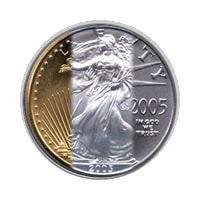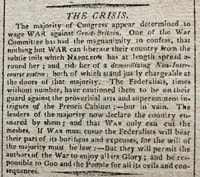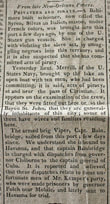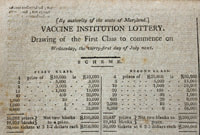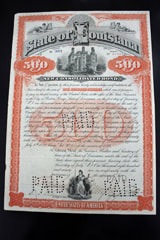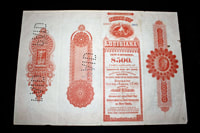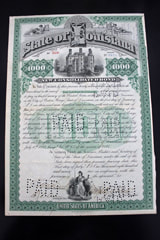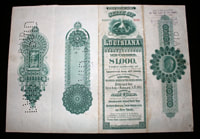Southland Coins & Collectibles Inc.
4670 Lake Street
Documents and Maps
London Gazette Newspapers from 1711 - $19.95 each
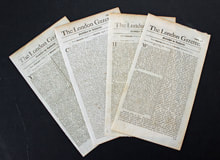
The London Gazette is one of the official journals of record of the government of the United Kingdom. It was first published as The Oxford Gazette on November 7, 1665 and claims to be the oldest surviving English newspaper and the oldest continuously published newspaper in the UK, having been first published on November 7, 1665, as The Oxford Gazette. King Charles II and the Royal Court had moved to Oxford to escape the Great Plague of London, and courtiers were unwilling to touch London newspapers for fear of contagion. The Gazette was “Published by Authority” by Henry Muddiman. When the king returned to London once the plague dissipated, the Gazette also moved, and the first issue of The London Gazette was published on February 5, 1666. The Gazette was not a newspaper in the modern sense: it was sent by post to subscribers, not printed for sale to the general public. Her Majesty's Stationery Office took over the publication of the Gazette in 1889. Publication of the Gazette was transferred to the private sector in 2006, under government supervision, when HMSO was sold and renamed The Stationery Office.
Note that each issue is only one page, front and back. All are original and were printed in 1711. Specific dates our choice. Click on the image to see a larger representation of the gazettes.
Note that each issue is only one page, front and back. All are original and were printed in 1711. Specific dates our choice. Click on the image to see a larger representation of the gazettes.
National Intelligencer Newspapers from 1811 - $19.95 each
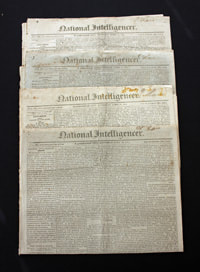
The National Intelligencer began as a tri-weekly, first issued on October 31, 1800. It became a daily in 1813, and ceased publication January 10, 1870. It reported and published Congressional debates and gained a national reputation as one of the leading newspapers in the United States. Two of the men who owned the paper, Joseph Gales (1786-1860) and William Seaton (1785-1866) reported on important debates in Congress and both later served as mayor of Washington, D.C. in the 1820s and 1840s.
These issues were published in 1811, from Washington City (Washington, D.C.), just prior to the War of 1812. Specific dates our choice. Click on the image to see a larger representation of the newspapers.
These issues were published in 1811, from Washington City (Washington, D.C.), just prior to the War of 1812. Specific dates our choice. Click on the image to see a larger representation of the newspapers.
Columbian Centinel Newspapers from 1811 - $19.95 each
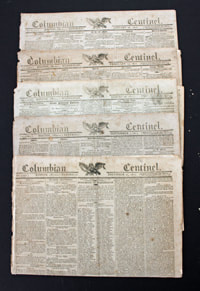
The Columbian Centinel (1790–1840) was a Boston, Massachusetts, newspaper established by Benjamin Russell. It continued its predecessor, the Massachusetts Centinel and the Republican Journal, which Russell and partner William Warden had first issued on March 24, 1784. In the Federalist Era (1788-1800), it was aligned with Federalist sentiment. Until around 1800 its circulation was the largest in Boston, and its closest competitor was the anti-Federalist Independent Chronicle.
In 1828 Russell sold the Centinel to Joseph T. Adams and Thomas Hudson, who continued publishing it. In 1840, the Centinel merged with a number of other Boston papers—the Independent Chronicle & Boston Patriot, the Boston Commercial Gazette, and the New-England Palladium—to form the Boston Semi-weekly Advertiser, which eventually became the Boston Herald. Specific dates our choice. Click on the image to see a larger representation of the newspapers.
Below are sample articles from issues of the Columbian Centinel. Click on the images to read the articles.
In 1828 Russell sold the Centinel to Joseph T. Adams and Thomas Hudson, who continued publishing it. In 1840, the Centinel merged with a number of other Boston papers—the Independent Chronicle & Boston Patriot, the Boston Commercial Gazette, and the New-England Palladium—to form the Boston Semi-weekly Advertiser, which eventually became the Boston Herald. Specific dates our choice. Click on the image to see a larger representation of the newspapers.
Below are sample articles from issues of the Columbian Centinel. Click on the images to read the articles.
Pennsylvania Gazette - Benjamin Franklin Publisher - $2,850.00
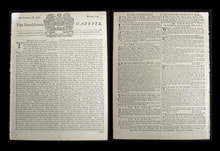
The newspaper was first published in 1728 by Samuel Keimer. It was the second newspaper to be published in Pennsylvania under the name The Universal Instructor in all Arts and Sciences: and Pennsylvania Gazette. Keimer’s intention was to print out a page of Ephraim Chambers’ Cyclopaedia in each copy. Benjamin Franklin and Hugh Meredith bought the paper in 1729 and shortened its name and dropped plans to print out pages of the Cyclopaedia. Franklin not only printed the paper but also often contributed pieces to the paper under various aliases. His newspaper soon became the most successful in the colonies.
The publication featured classified ads, employment notices, items for sale, travel stories along with reprints of foreign news. The newspaper ceased publication in 1800, ten years after Franklin’s death. This particular issue is from 1740, 35 years before the start of the Revolutionary War! Click on the image to see a larger representation of the gazette.
The publication featured classified ads, employment notices, items for sale, travel stories along with reprints of foreign news. The newspaper ceased publication in 1800, ten years after Franklin’s death. This particular issue is from 1740, 35 years before the start of the Revolutionary War! Click on the image to see a larger representation of the gazette.
State of Louisiana Bonds
State of Louisiana Reconstruction Bond
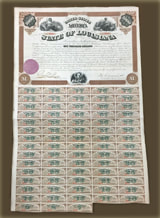
A beautiful $1,000 bond printed by the National Banknote Company and issued to the New Orleans, Mobile, and Chattanooga Rail Road Company or Bearer. Measuring approximately 16 3/4 inches wide by 26 inches long, the bond has an ornate brown border around it with vignettes of Agriculture and Commerce at the top.
At the bottom of the bond is a vignette of the state bird, a brown pelican, with her four nestlings, and the words "I live and die for those I love". The mother, with drops of blood on her breast, has wounded herself to feed her own blood to her young. The bond is signed by impeached Governor Henry Clay Warmoth and Secretary of State George E. Bovee. Below the bond were 79 coupons, in green and brown with the bond number 2188 in red, each paying semi-annual interest of $40 interest when redeemed. Six coupons had previously been clipped and redeemed.Giori Test Note Single with vignettes of Presidents Abraham Lincoln, George Washington, and Ulysses S. Grant. Opposite side of note is blank. Click on the image to see a larger representation of the bond.
At the bottom of the bond is a vignette of the state bird, a brown pelican, with her four nestlings, and the words "I live and die for those I love". The mother, with drops of blood on her breast, has wounded herself to feed her own blood to her young. The bond is signed by impeached Governor Henry Clay Warmoth and Secretary of State George E. Bovee. Below the bond were 79 coupons, in green and brown with the bond number 2188 in red, each paying semi-annual interest of $40 interest when redeemed. Six coupons had previously been clipped and redeemed.Giori Test Note Single with vignettes of Presidents Abraham Lincoln, George Washington, and Ulysses S. Grant. Opposite side of note is blank. Click on the image to see a larger representation of the bond.
Dewey Defeats Truman Newspaper dated November 3, 1948 - $2,995.00
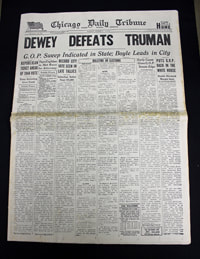
There was no love lost between the Republican-leaning Chicago Daily Tribune (later changed to the Chicago Tribune) and Democratic presidential candidate Harry Truman, so when the newspaper reported that Dewey won, Truman was jubilant as he held up a copy of the erroneous headlines in a famous photograph of his triumph.
Prior to the 1948 election, printers who operated linotype machines at Chicago newspapers had been on strike, protesting the Taft-Hartley Act. About the same time, the Tribune had switched to copying the paper that was composed on typewriters, photographed and then engraved on printing plates. With this process, the paper had to go to press several hours earlier than usual.
On election night, the first edition had to go to press even before poll results from the East Coast were available. The paper relied on Arthur Sears Henning, its veteran Washington political analyst and correspondent who had picked the presidential winner over the last 20 years, along with public opinion polls and conventional wisdom that Dewey was sure to be the winner. So the first edition of the Tribune led with the headline “Dewey defeats Truman.”
It was not only a victory for Truman but also for the Democrats, who took control of both the House of Representatives and the Senate. Click on the image to see a larger representation of the newspaper.
Prior to the 1948 election, printers who operated linotype machines at Chicago newspapers had been on strike, protesting the Taft-Hartley Act. About the same time, the Tribune had switched to copying the paper that was composed on typewriters, photographed and then engraved on printing plates. With this process, the paper had to go to press several hours earlier than usual.
On election night, the first edition had to go to press even before poll results from the East Coast were available. The paper relied on Arthur Sears Henning, its veteran Washington political analyst and correspondent who had picked the presidential winner over the last 20 years, along with public opinion polls and conventional wisdom that Dewey was sure to be the winner. So the first edition of the Tribune led with the headline “Dewey defeats Truman.”
It was not only a victory for Truman but also for the Democrats, who took control of both the House of Representatives and the Senate. Click on the image to see a larger representation of the newspaper.
